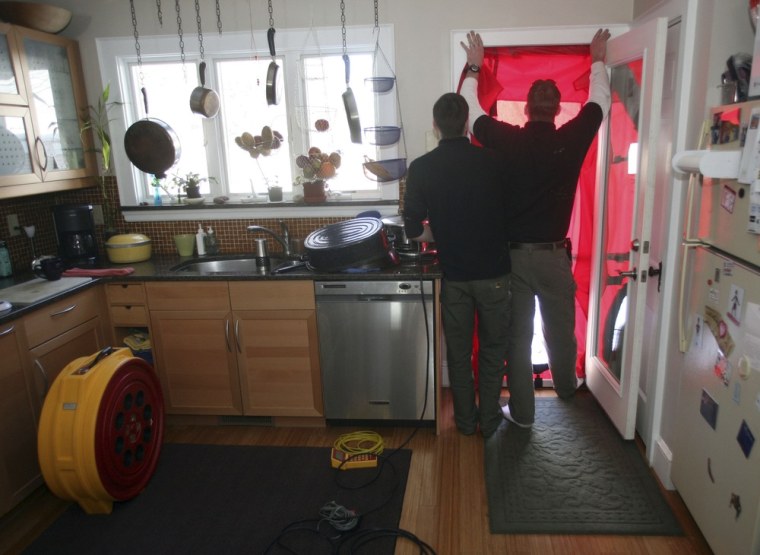Shortly after Jason Raddenbach and his family moved into their Janesville, Wis., home, he discovered the cost of keeping the place warm in the winter to be exorbitant.
“It was only about 1,200 square feet and it was just costing a mint to heat the thing,” says Raddenbach. Describing it as "sticker shock," Raddenbach recalls a December heating bill of $133 before it topped out at $248 in February.
With winter on the way and money-saving tax breaks about to expire, experts say now is a good time for homeowners to consider weatherization.
In late 2003, after receiving his first in a series of monster bills, Raddenbach hired a professional to conduct an energy audit. He followed up on the advice by taking a few months to replace an aging furnace as well as add attic insulation, a chimney damper and foam sealer to fill cracks. The family’s natural gas consumption dropped by 46 percent.
Impressed by the savings in cost and consumption, Raddenbach started a side business to sell inflatable chimney dampers, a venture he took full-time in 2008 as demand increased. Raddenbach might have been an early adopter, but he has plenty of company these days.
Energy auditors report growing interest in cutting heating costs by weatherizing homes. Brett Knox, chief executive of Irvine, Calif.-based GreenHomes America, says demand has jumped 30 percent since the start of 2009. To defray the costs to low-income homeowners, a Department of Energy program has helped weatherize 200,000 homes, and the government agency is aiming for 600,000 by March 2012.For homeowners paying out of pocket, an energy audit generally costs around $400, with larger homes commanding a higher price tag. The DOE suggests homeowners that don’t qualify for the program should contact their local utility company since some partner with local companies to offer discounts on the price of the audit.

The home audit can last three to four hours. Professionals use a blower door and infrared camera to discover where air escapes. The blower is temporarily installed in a doorway and creates a slight negative pressure inside the home. The auditor then looks for places where air is entering – and, thus, escaping – the house. The camera acts as a kind of an X-ray to reveal leaks behind the walls.
Mark Cannella, chief technical officer at Cleveland-based Pro Energy Consultants, says the cost of patching leaks generally runs between $1,500 and $2,500. Cannella says most people think their biggest source of leaks will be windows, but that’s generally not the case.
“The reality is windows only make up about 17 percent of the entire wall area,” Cannella says. “It’s not a huge percentage of loss.”
Heat more commonly slips out through outlets and light switches on exterior walls and from recessed lighting. Other trouble spots are attics and crawl spaces with little or no insulation, and leaky ductwork through which warm air escapes before it ever reaches the rooms.
Many of the crevices and gaps auditors find are small, but those tiny holes add up. Tony Vacc, a homeowner in Aurora, Ohio, who had an energy audit done in June 2009, says the professional found the equivalent of an eight-square-foot gap in his house.
“It’s surprising how many quarter-inch holes there are in the house that add up to eight square feet,” he says. Vacc estimates he spent 120 hours caulking, insulating and sealing leaks, while he paid to have leaky attic ductwork repaired.
“I probably consumed about 20 tubes of caulk,” he says. The elbow grease was worth it, though; Vacc says his natural gas usage dropped by 35 or 40 percent year over year.
With the exception of the ductwork, which can be technically complex, homeowners can do many of the necessary fixes themselves. Until the end of this year, there is a federal tax credit to . The credit lets homeowners claim 30 percent of the cost of insulation, caulking, weather-stripping and other weatherization goods, up to a total of $1,500.
The prospect of getting money back and being environmentally conscious at the same time is what motivated Robin Kastenmayer to improve her place. Kastenmayer, a homeowner in Kensington, Md., had her house weatherized in June.
“We’ll be able to get back $400 to $500, and our power company also gives back $150 towards the cost of the improvements,” says Kastenmayer. Finding a service provider she felt she could trust was a challenge though.
“A lot of them seemed to focus on replacing windows,” she says. “That’s a huge cost. I didn’t want them to focus on that and not my underlying problem.”
In the end, Kastenmayer selected a company that she felt had her concerns and not their own bottom line in mind. “Their website went the extra step of focusing on the homeowner’s concerns. It wasn’t a hard sell,” she says.
Although the DOE is in the process of creating a certification for home energy auditors, right now there’s no single standard. This means consumers are somewhat on their own when it comes to finding a home auditor.
The department’s website has a list of criteria homeowners can use to help them hire an energy professional. Some weatherization companies are certified by the Building Performance Institute, a weatherization training organization. As with any service professional, prospective customers should seek references from the company’s clientele and calls should be made to them to measure their experience. Ask the company how much you can expect to save on your energy bills and ask former clients if the company delivered the promised savings.
Homeowners on the fence about weatherization are in good company. Raddenbach recalls some initial worry about whether his investment would pay off.
"Whenever you put a significant amount of money into improvements, you've got an expectation," he says. "To be honest, it exceeded my expectation."